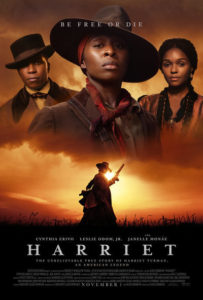 Harriet Tubman. What a legendary American. We all studied her in elementary school and then again in high school. We know that she was born into slavery, escaped, and was an integral leader in the Underground Railroad that helped free slaves before the United States Civil War. Cynthia Erivo (Widows, Bad Times at the El Royale) pours her heart and soul into the title role and makes Kasi Lemmons’ (Eve’s Bayou, Talk to Me) Harriet a must-see for anyone over twelve. It is the first time Tubman’s story has been captured in biopic form. This film is so well told that it won’t need to be retold (in big production film form) for a long time. It’s one of the best history lessons you could hope to have on another person. It’s brutally honest. It doesn’t drag its feet. It’s entertaining. It brings to the big screen a real-life American hero who deserves all the fame and glory she is due. Harriet is a 2019 big, big win.
Harriet Tubman. What a legendary American. We all studied her in elementary school and then again in high school. We know that she was born into slavery, escaped, and was an integral leader in the Underground Railroad that helped free slaves before the United States Civil War. Cynthia Erivo (Widows, Bad Times at the El Royale) pours her heart and soul into the title role and makes Kasi Lemmons’ (Eve’s Bayou, Talk to Me) Harriet a must-see for anyone over twelve. It is the first time Tubman’s story has been captured in biopic form. This film is so well told that it won’t need to be retold (in big production film form) for a long time. It’s one of the best history lessons you could hope to have on another person. It’s brutally honest. It doesn’t drag its feet. It’s entertaining. It brings to the big screen a real-life American hero who deserves all the fame and glory she is due. Harriet is a 2019 big, big win.
The ideal subject for a biopic, Tubman’s story in Harriet begins in 1849 when, at the age of 24, she provides documents to her plantation owner Edward Brodess from a lawyer that proves that Harriet’s mother was supposed to be a free woman and, therefore, all of her children as well. Knowing he’ll lose money if Harriet and her siblings are freed, Brodess rips the letter and denies the request. Furthermore, his son, Gideon (Joe Alwyn – The Favourite, Boy Erased), decides to sell Harriet (then known as Minty) downriver, where she’ll never see her family or husband again. Knowing that her only hope of freedom is to escape, Minty attempts to do just that: fleeing from Poplar Neck (Caroline County, Maryland), walking 100+ miles to Philadelphia, PA, and gaining her freedom.

It is there that Minty takes on the new name of Harriet Tubman, and it is here that she gains her folklore notoriety as a leader on the Underground Railroad, where she makes multiple trips, aiding a handful of slaves each time to escape freedom to at first, Pennsylvania and, eventually, Canada. Her first trip back to her former slave plantation is to rescue her husband, John, her sister, Rachel, and her brothers. She learns that John has remarried and that Rachel is unwilling to leave the plantation out of fear of what might happen to her, but her brothers are ready to follow. Thus begins some harrowing, edge-of-your-seat sequences between Harriet and her escapees and the wealthy, white landowners who will do anything to prevent them from reaching their freedom.
Unlike masterpieces like 12 Years a Slave, we hear about many of the bad things happening to Harriet Tubman and the other slaves rather than see them. That’s not to say that this is a PG movie. There are certainly a few sequences that make us cringe and cry out, wondering how any human being could do the things we see to another human being. But we see the whip marks on the backs instead of witnessing the lashings. It certainly isn’t a criticism or even a critique. It’s just to mention the approach that Lemmons decided to take. Combine that with some characters, outside of Harriet and Gideon, that felt a tad flat and one-dimensional, and you have a movie that wouldn’t affect you in as many ways as possible. I wouldn’t suggest an R-rating, just to include more gut-wrenching scenes, but this movie is certainly toned down from what it could have been.

A slight criticism of the film is that the protagonist/antagonist angle of Harriet and Gideon slightly overshadows the Underground Railroad. The (fictionalized) war between the two individuals takes precedence in ways it doesn’t need to. Sure, we needed antagonists, and we needed them to have a face. But, if that was the goal, the mission was accomplished. I didn’t necessarily think that we had to keep coming back to this one-on-one battle each time Harriet came back south in her attempts to free more slaves.
Overall, Harriet is a great biopic that could be used as a substitute/complement to the unit in American history that focuses on Tubman and the Underground Railroad. It’s an educational and entertaining film that doesn’t necessarily need to be seen on the big screen (though your experience will be enhanced if you can see it at your local theater). However, it should still be seen by as many people as possible. It’s a win.
A-
Plot 10/10
Character Development 8/10
Character Chemistry 8/10
Acting 9/10
Screenplay 9.5/10
Directing 9.5/10
Cinematography 9.5/10
Sound 8/10
Hook and Reel 9/10
Universal Relevance 10/10
91.5%